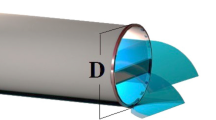Abstract
The friction coefficient is widely used for technical and economical design of pipes in irrigation, land drainage, urban sewage systems and intake structures. In the present study, the friction factor in pipes is estimated by using adaptive neuro-fuzzy inference system (ANFIS) and grid partition method. The data derived from the Colebrook’s equation were considered for ascertaining the neuro-fuzzy model. Present approach developed an ANFIS technique to predict the friction coefficient as output variable based on pipe relative roughness and Reynold’s number as input variables. The performance of the ANFIS model was evaluated against conventional procedures. Correlation coefficient (R2), root mean squared error and mean absolute error were used as comparing statistical indicators for the assessment of the proposed approach’s performance. It was found that the adaptive neuro-fuzzy inference system model is more accurate than other empirical equations in modeling friction factor.


Similar content being viewed by others
References
Yuhong, Z., Wenxin, H.: Application of artificial neural network to predict the friction factor of open channel flow. J. Elsevier 14, 2373–2378 (2009)
Maghrebi, F.M., Givehchi, M.: Estimation of depth-averaged velocity and boundary shear stress in a triangular open channel. J. Water Wastewater 2, 71–80 (2009). (In Persian)
Yildirim, G., Ozger, M.: Neuro-fuzzy approach in estimating Hazen-Williams friction coefficient for small-diameter polyethylene pipes. J. Elsevier 40, 593–599 (2009)
Christensen, B.A.: Discussion of Limitations and proper use of the Hazen–Williams equation by C.P. Liou. J. Hydraul. Eng. 126(2), 167–168 (2000)
Liou, C.P.: Limitations and proper use of the Hazen–Williams equation. J. Hydraul. Eng. 124(9), 951–954 (1998)
Moghazi, H.M.: Estimating Hazen–Williams coefficient for polyethylene pipes. J. Transp. Eng. 124(2), 197–199 (1998)
Valiantzas, J.D.: Modified Hazen-Williams and Darcy-Weisbach equations for friction and local head losses along irrigation laterals. J. Irrig. Drain Eng. 131(4), 342–350 (2005)
vonBernuth, R.D.: Simple and accurate friction loss equation for plastic pipe. J. Irrig. Drain Eng. 116(2), 294–298 (1990)
Walid, H.S., Shyam, S.S.: An artificial neural network for non-iterative calculation of the friction factor in pipeline flow. J. Comput. Electron. Agric. 21, 219–228 (1998)
Colebrook, C.F., White, C.M.: Experiments with fluid friction in roughened pipes. Proc. R. Soc. A. Mat 161, 367–381 (1937)
Goudar, C.T., Sonnad, J.R.: Comparison of the iterative approximations of the Colebrook–White equation. J Hydrol. Proc. 87, 79–83 (2008)
Yıldırım, G., Ozger, M.: Determining turbulent flow friction coefficient using adaptive neuro-fuzzy computing technique. J. Elsevier 40, 281–287 (2009)
Moody, L.F.: An approximate formula for pipe friction factors. J. Trans. ASME 69, 1005–1006 (1947)
Wood, D.J.: An explicit friction factor relationship. ASCE J. Civil Eng. 36(12), 60–61 (1966)
Swamee, P.K., Jain, A.K.: Explicit equations for pipe-flow problems. J. Hydrol. Div. ASCE 102(5), 657–664 (1976)
Churchill, S.W.: Friction factor equation spans all fluid-flow regimes. J. Chem. Eng. 84(24), 91–92 (1977)
Chen, N.H.: An explicit equation for friction factor in pipe. J. Ind. Eng. Chem. Fundam. 18(3), 296 (1979)
Round, G.F.: An explicit approximation for the friction-factor Reynolds number relation for rough and smooth pipes. J. Can. Chem. Eng. 58(1), 122 (1980)
Barr, D.I.H.: Solutions of the Colebrook-White function for resistance to uniform turbulent flow. Proc. Inst Civil Eng 2(71), 529 (1981)
Zigrang, D.J., Sylvester, N.D.: Explicit approximations to the solution of Colebrook’s friction factor equation. J. AIChE 28, 514–515 (1982)
Haaland, S.E.: Simple and explicit formulas for the friction factor in turbulent pipe flow. J. Fluids Eng. 105(1), 89–90 (1983)
Manadilli, G.: Replace implicit equations with signomial functions. J. Chem. Eng. 104(8), 129 (1997)
Romeo, E., Royo, C., Monzon, A.: Improved explicit equations for estimation of the friction factor in rough and smooth pipes. J. Chem. Eng. 86(3), 369–374 (2002)
Sonnad, J.R., Goudar, C.T.: Turbulent flow friction factor calculation using mathematically exact alternative to the Colebrook-White equation. J. Hydrol. Eng. ASCE 132(8), 863–867 (2006)
Karamouz, M., Tabesh, M., Nazif, S., Moridi, A.: Estimating of hydraulic pressurein water networks using artificial neural networks and fuzzy logic. J. Water Wastewater 53, 3–14 (2006). (In Persian)
Jeon, J.: Fuzzy and Neural Network Models for Analyses of Piles. Thesis, North Carolina State University, USA, MS (2007)
Jang, J.-S.R.: ANFIS: adaptive-network-based fuzzy inference system. J. IEEE Trans. Syst. Man, Cyber. 23(3), 665–685 (1993)
Jang, J.-S.R., Sun, T.: Nuro-fuzzy modeling and control. Proc. IEEE 83, 378–405 (1995)
Basser, H., Shamshirband, S., Petković, D., Karami, H., Akib, S., Jahangirzadeh, A.: Adaptive neuro-fuzzy prediction of the optimum parameters of protective spur dike. Nat. Hazards, 73(3), 1439–1449 (2014)
Nauck, D., Klawonn, F., Kruse, R.: Foundations of Neuro-Fuzzy Systems. Wiley, Chichester (1997)
Jang, J.-S.R., Sun, T., Mizutani, E.: Neuro-Fuzzy and Soft Computing: A Computational Approach to Learning and Machine Intelligence. Prentice-Hall, Upper Saddle River (1997)
Varol, Y., Avci, E., Koca, A., Oztop, F., H.: Prediction of flow fields and temperature distributions due to natural convection in a triangular enclosure using Adaptive-Network-Based Fuzzy Inference System (ANFIS) and Artificial Neural Network (ANN). J. Elsevier 34, 887–896 (2007)
Dorum, A., Yarar, A., Sevimli, M.F., Onucyildiz, M.: Modelling the rainfall-runoff data of susurluk basin. J. Elsevier 37, 6587–6593 (2010)
Author information
Authors and Affiliations
Corresponding author
Rights and permissions
About this article
Cite this article
Bardestani, S., Givehchi, M., Younesi, E. et al. Predicting turbulent flow friction coefficient using ANFIS technique. SIViP 11, 341–347 (2017). https://doi.org/10.1007/s11760-016-0948-8
Received:
Revised:
Accepted:
Published:
Issue Date:
DOI: https://doi.org/10.1007/s11760-016-0948-8




